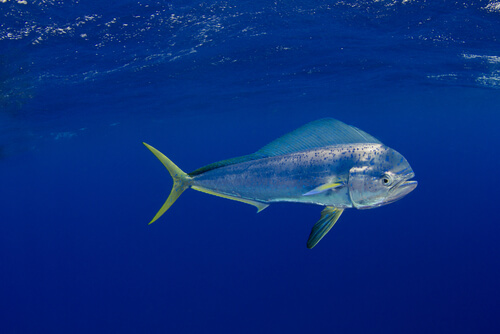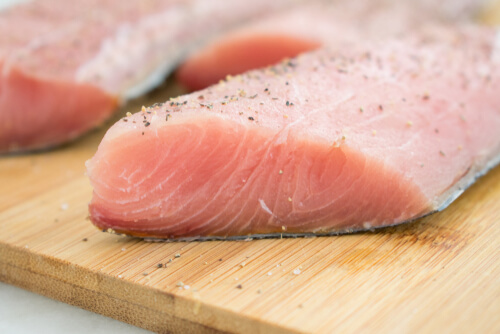
| Kingdom | Animalia |
| Phylum | Chordata |
| Class | Actinopterygii |
| Order | Carangiformes |
| Family | Coryphaenidae |
| Genus | Coryphaena |
| Species | C. hippurus |
| Niche | Pelagic predator |
| Length | 35 in (100 cm) |
| Weight | 15-30 lb (7-13 kg) |
| Lifespan | 5 years |
| Social Structure | Solitary or loosely schooling |
| Conservation Status | Least Concern |
| Preferred Habitat | Epipelagic waters (tropical, subtropical, temperate) |
| Average Clutch Size | 80,000-1,000,000 |
| Main Food Items and Prey | Fish, crustaceans, squids, etc. |
| Predators | Large tuna and billfish, toothed whales, sharks, sea lions, seals |
The Basics
The mahi-mahi, which is also commonly referred to as dorado and the common dolphinfish, is a medium-sized epipelagic fish of the family Coryphaenidae. It occurs in tropical, subtropical, and temperate waters around the oceans of the world including the Pacific, Atlantic, and Indian Oceans.
Description
The mahi-mahi has a distinct appearance, with a long, tall, and narrow body and a blunt head and mouth. They normally grow to around 30 pounds and 1 meter in length and are also distinguishable by their spectacular coloring. On their flanks, they are mostly a golden-yellow color with iridescent blue pectoral fins. Some individuals are spotted blue around their heads as well. They have a large, sail-like dorsal fin and a relatively large caudal or tail fin.

Distribution and Habitat
Mahi-mahi can be found throughout the world, particularly in tropical, subtropical, and temperate waters. They are commonly observed in Hawaii, throughout Central America and Mexico, as well as much of the Indian Ocean.
They are epipelagic, spending most of their time offshore and relatively near the surface. Although they are known to dive to depths nearing 1,000 feet, they can typically be found in the 100 feet nearest to the surface.
Diet and Predators
Mahi-mahi are predatory fish. They rely on their speed and their large mouths to capture various prey species including small fish. They will also hunt cephalopods such as squid and cuttlefish as well as various crustaceans. Juveniles in particular are also known to feed on zooplankton, small animals floating the oceans at the whim of the currents.

In turn, mahi-mahi are also on the menu for other marine predators. Large tuna species such as the yellowfin tuna and bluefin tuna will hunt virtually any fish within the right size range, including young mahi-mahi. This is also true for toothed whales such as dolphins, orca, and the false killer whale, all of which have an overlapping range with mahi-mahi. Other marine mammals such as sea lions and seals as well as various pelagic shark species such as the mako shark and blue shark will also feed on mahi-mahi when provided the opportunity.
Reproduction and Life Cycle
Mahi-mahi is a fast-growing species, with both females and males normally reaching sexual maturity within their first year of life. The spawning season typically occurs two or three times per year, with females producing anywhere between 80,000 and 1,000,000 eggs during each spawning season. During these periods, females will release tens of thousands of eggs every few days until they are spent. Males will also release their sperm into the water column, where external fertilization of the egg takes place, creating an embryo.
Within a few days, this embryo hatches, becoming a larval fish and part of the zooplankton community. Once large enough, juvenile mahi-mahi will take to hunting their own prey, and may spend their first phase of life amongst Sargassum spp. and other seaweeds and algae, hiding from larger fish and the strong currents of the open ocean.

Mahi-mahi are fast-growing and relatively short-lived, reaching a maximum age of around 5 years. However, most individuals are not believed to make it past the age of four.
Conservation Status
Traditionally treated as bycatch in other fisheries such as tuna, mahi-mahi is now a popular commercial and sport fishery target. Due perhaps in part to their fast growth rate, current mahi-mahi stocks are believed to be relatively strong and sustainable. As a result, the species is listed as Least Concern on the IUCN Red List of Threatened Species.
Fun Facts about Mahi-mahi!
The mahi-mahi is a fascinating species. Not only is it large, fast, powerful, and unique, it is a highly popular game fish and commercial fishery target. With a closer look at the species, there are even more fun facts and interesting insights to explore through the lens of the mahi-mahi.
Fastest Growing
Mahi-mahi are a relatively fast-growing species. They can grow up to 2.7 inches per week and can reach their adult size within about one year, normally becoming sexually mature at just 5-6 months of age. Due to this trait, it is sometimes referred to as the rabbit of the sea.
Like rabbits, they also reproduce rapidly. During their spawning season, which may occur up to three times per year, females will spawn every 2-3 days, releasing tens of thousands of eggs each time.

Not only does this fast growth rate allow the fish a better chance of survival during its first year, but it also has a convenient side-effect for humans, for whom the popularity of mahi-mahi as a target of sport and commercial fisheries continues to increase. Because of this fast growth rate and high level of fecundity, it is one of the relatively few species that is currently fished sustainably.
On the Fly
The mahi-mahi is a predatory species, feeding on all kinds of marine organisms. In particular, they hunt various species of smaller fish. One prey species of mahi-mahi is particularly interesting. The flying fish is known to ‘fly’, in which it actually ‘skims’ across the water in a series of shallow-trajectory jumps. The mahi-mahi is particularly well-known for being well-adapted to hunting flying fish. In fact, it is so well adapted that it is estimated that the flying fish alone makes up about 25% of the mahi-mahi’s diet by weight.
Not a Dolphin
Common names of species, although useful in their own right, can also create a fair amount of confusion when it comes to people’s understanding of the natural world. The mahi-mahi, for example, has a variety of common names. “Mahi-mahi” itself is derived from the Hawaiian language and means “strong”. While “dorado”, for instance, is used in many parts of its range including Mexico and Central America. Meaning “golden” in Spanish, this common name makes reference to the fish’s distinct yellow-gold coloring over much of its body. However, there is also a freshwater fish, Salminus brasiliensis, that is known by the same common name in some of the same regions, including Central America. This fish, however, is of no evolutionary relation or resemblance to the mahi-mahi.
Another common name for this species is the “common dolphinfish”. Historically, they were referred to as dolphin, although dolphinfish was relatively recently adopted to avoid mistaken them with the popular marine mammals. Dolphins are marine mammals, so it is difficult to see why they share a common name historically. There are various theories about the origins of the term dolphin or dolphinfish for members of the genus Coryphaena, but it remains unclear which is true.
